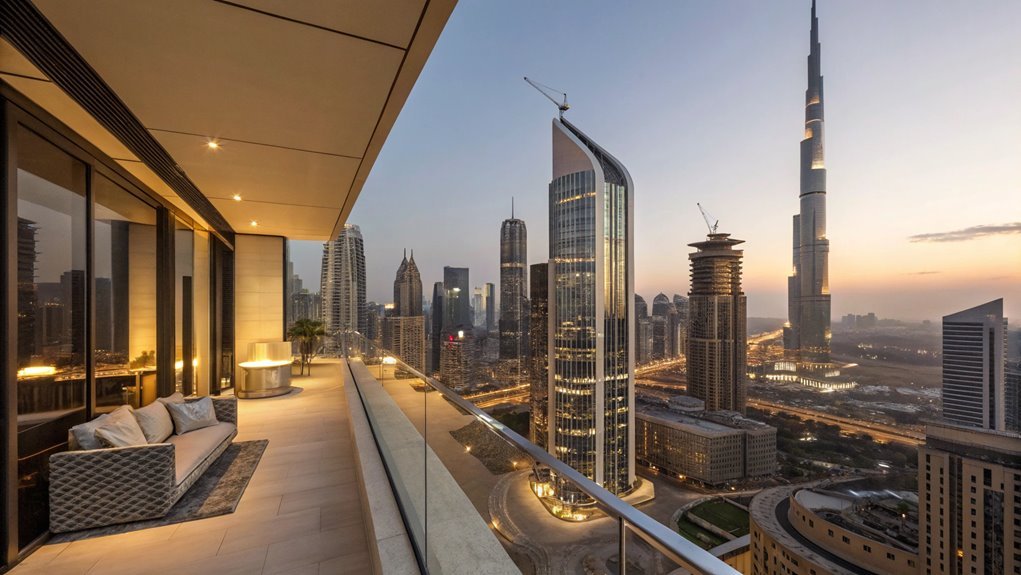How Do Short-Term and Long-Term Rentals in Dubai Differ in Terms of ROI?

In Dubai, short-term rentals typically offer a higher ROI of 12-15% per year, largely due to high nightly rates in popular areas like Dubai Marina. These rentals thrive during peak tourist seasons but contend with variable occupancy rates of 50-65%.
In contrast, long-term leases provide a steadier ROI of 5-8%, supported by stable occupancy rates of 85-95%. Short-term rentals incur higher costs, including management fees and taxes, yet they can charge premium prices during high-demand periods.
For long-term rentals, predictable expenses and tenant-managed utilities simplify budgeting. To gain deeper insights, consider how market dynamics impact these returns.
Key Takeaways
- Short-term rentals in Dubai yield 12-15% annually, while long-term leases typically yield 5-8%.
- High per-night rates in prime locations enhance short-term rental profitability.
- Long-term rentals provide stable income with 85-95% occupancy, ensuring predictable returns.
- Short-term rentals incur higher operating costs, offsetting some of the increased revenue potential.
- Strategic pricing and management during peak seasons maximize short-term rental ROI.
ROI Comparison

In Dubai, short-term rentals offer higher ROI, with annual yields of 12-15%, compared to 5-8% from long-term leases. This is due to higher per-night rates in high-demand areas like Dubai Marina, Downtown Dubai, and Palm Jumeirah. Short-term rentals can command premium rates during peak tourist seasons, enhancing their profitability. While short-term rentals average 50-65% occupancy, prime locations can reach 75% with professional management. Additionally, the strategic location of Dubai at the crossroads of Europe, Asia, and Africa, further boosts demand for short-term rentals, attracting business and leisure travelers alike. However, maintenance and management costs can reduce returns if not managed well. Long-term rentals provide stable income with 85-95% occupancy due to fixed lease terms, though at lower yields.
Let us help you find the perfect property. Contact us to get started.
Seasonal Impacts
Navigating Dubai's rental market requires understanding seasonal demand and pricing strategies. From November to March, short-term rental demand peaks due to favorable weather and events like the Dubai Shopping Festival, with luxury properties fetching around $250 per night. In contrast, summer sees a price drop as temperatures rise, though demand from locals and business travelers remains steady, providing an opportunity for property maintenance. While agencies can't control market cycles, reduced seasonality due to rising demand and fixed rates allows for strategic planning. Interestingly, the rising demand during summer months, contrary to typical low season expectations, has contributed to a shift in tenant behavior.
Occupancy Rates

Grasping occupancy rates in Dubai's rental market is key for optimizing property investment returns. Short-term rentals see 50-65% annual occupancy, spiking to 80-90% in peak seasons in prime areas like Dubai Marina and Downtown Dubai due to their proximity to attractions. Professionally managed properties can reach 95% occupancy in certain months with dynamic pricing. Long-term rentals sustain nearly 100% annual occupancy but yield lower revenue. Short-term rentals offset lower occupancy with higher nightly rates. Investors are attracted to Dubai's strategic location and tax-free environment, which further enhances the demand for both short-term and long-term rentals. To maximize ROI, focus on effective management to boost tenant days and apply premium pricing during high-demand periods, especially for luxury and well-located units.
Operating Costs
Operating costs significantly affect the profitability of rentals in Dubai. Short-term rentals incur management fees of about 15% of the nightly rate, along with utility and maintenance costs. Long-term rentals generally have lower or no management fees as tenants typically manage utilities and minor repairs. Dubai ranks among the most visited cities globally, with the short-term rental market experiencing substantial growth. Here's a breakdown:
| Cost Category | Short-Term Rentals | Long-Term Rentals |
|---|---|---|
| Management Fees | 15% plus performance | Low or absent |
| Utility Bills | Owner's responsibility | Tenant's responsibility |
| Maintenance & Repairs | Managed with contractors | Tenant/Owner split |
Short-term rentals also face costs like annual permits and Tourism Dirham tax, whereas long-term rentals have fewer extra expenses, offering more predictable budgeting.
Market Trends

Dubai's rental market is evolving with a 30% rise in short-term rentals due to tourism and demand for luxury holiday homes, particularly in Business Bay and Palm Jumeirah. These rentals fluctuate seasonally. Technological innovations and stricter regulations will continue to influence the sector, encouraging consolidation and attracting new players. The average annual yield for long-term leases is around 7%, indicating that while short-term rentals yield higher returns, long-term leases provide consistency. Long-term rentals, driven by expatriate demand, offer stable income with up to 31% rent increases in prime areas like Downtown Dubai and Business Bay. Both markets are growing, with significant increases in property transactions.
Frequently Asked Questions
What Are the Legal Requirements for Short-Term Rentals in Dubai?
You must obtain a tourism license from DTCM, register your property, and pay permit fees. Guarantee compliance with health and safety guidelines, execute legal contracts, and manage tenant screening. Non-compliance results in fines and penalties.
How Do Short-Term Rental Platforms Impact Rental Success?
You greatly enhance rental success by using short-term rental platforms. They increase visibility, boost occupancy, and provide pricing tools. Although commission fees reduce net yields, professional management and amenities can elevate guest satisfaction and maximize bookings.
Are There Specific Neighborhoods Better Suited for Short-Term Rentals?
You should focus on Downtown Dubai, Dubai Marina, and Jumeirah for short-term rentals. These areas offer high demand due to tourist attractions, nightlife, and amenities, leading to potentially higher occupancy rates and increased rental income.
What Insurance Policies Are Recommended for Rental Properties in Dubai?
You should consider landlord insurance covering property damage and loss of rental income. Liability insurance is essential for tenant injuries. Contents insurance protects furnishings, especially for short-term rentals. Guarantee compliance with Dubai's specific insurance regulations to minimize risks.
How Do Currency Fluctuations Affect Rental Income for International Investors?
Currency fluctuations impact your rental income as an international investor by altering property value and returns. A strong GBP reduces costs, while a weak GBP increases investment expenses, affecting both purchase affordability and ongoing rental profits.
Conclusion
In Dubai, short-term rentals often offer higher ROI due to dynamic pricing and high demand during peak seasons. However, they come with fluctuating occupancy rates and increased operating costs.
Long-term rentals provide more stable income and lower management expenses. Though, the ROI can be lower due to fixed rental rates.
Ultimately, your choice should align with your financial goals and risk tolerance. Consider both current market trends and projected economic growth in Dubai's real estate sector.
Let us help you find the perfect property. Contact us to get started.






